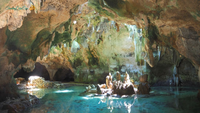Navdarism: Difference between revisions
mNo edit summary |
mNo edit summary |
||
| Line 29: | Line 29: | ||
===Architecture=== | ===Architecture=== | ||
<center> | |||
<gallery widths="200px" heights="150px"> | |||
File:The_Monastery%2C_Petra%2C_Jordan8.jpg|[[Old Temple of Murash|The Old Temple]], in the [[Sifharan]] country of [[Saria]] | |||
File:Sefadaba.png|[[Sefadaba Cave]], in the [[Sifharan]] country of [[Saria]] | |||
</gallery> | |||
</center> | |||
===Art=== | ===Art=== | ||
| Line 37: | Line 44: | ||
===Calendar=== | ===Calendar=== | ||
==Criticism, persecution, and apologetics== | |||
===Criticism=== | |||
===Persecution=== | |||
===Apologetics=== | |||
Revision as of 21:20, 27 March 2020

| Part of a series on |
| Zohism |
|---|
 |
Navdarism (translation) is the world's second-largest religion, and one of the world's oldest continuously practiced religions. Navdarism is a monistic faith, with elements of henotheism and atheism, centered on an eschatological cosmology dealing with self-salvation and spiritual liberation. It also encompasses a variety of traditions, beliefs and spiritual practices largely based on the original teachings of Nawdhar. It originated in ancient Poureman in the 11th century BCE, and, after a period of intense suppression, spreading through much of Sifhar, Arabekh, Majula, and Catai. Three major extant branches of Navdarism are generally recognized: Benayine (Pouremanian: lit. Seeing through the Mirror), Mehtaraina (Pouremanian:Order of the Elders), and Vasborya (Pouremanian:lit. Dancing on the Tower)
Terminology
Beliefs
Practices
Scriptures
History
Life of Nawdhar
Demographics
Schools
Society
Culture
Architecture
The Old Temple, in the Sifharan country of Saria
Sefadaba Cave, in the Sifharan country of Saria

